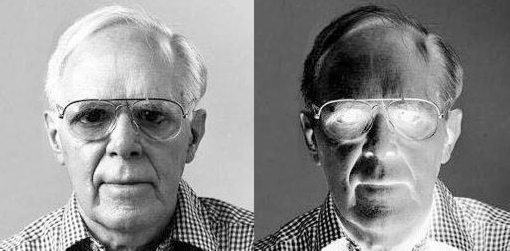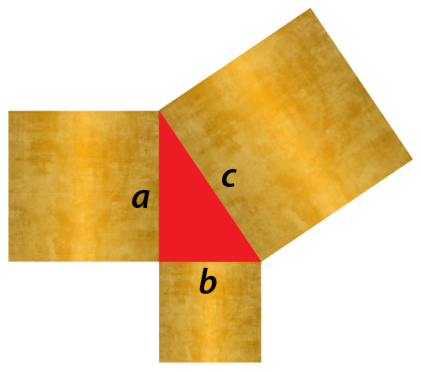Martin Gardner and Mr. Hyde
Burkard Polster and Marty Ross
The Age, 20 October 2014

"Why can't you be more like Martin Gardner?" So has been the refrain from some of your Maths Masters' disgruntled readers. Well, the answer is pretty simple: we're not as smart as Martin Gardner, we can't write nearly as well as him and our limited talents haven't been honed by fifty years of practice. The request is as wildly optimistic as our wives' plea that we be more like George Clooney.
Martin Gardner, of course, was the legendary mathematics populariser. Though not himself a mathematician or teacher, Gardner probably inspired more children to pursue mathematics than anyone before him or since. For thirty years he wrote the wonderful Mathematical Games column for Scientific American. The columns have been collected in fifteen books, amounting to a treasure trove of beautiful and beautifully presented mathematics. Gardner died in 2010, at the age of 95; tomorrow is the centenary of his birth.
To be fair, the dissatisfaction with your Maths Masters hasn't been primarily with our failure to write as stylishly as Martin Gardner. Rather, the request has been that we devote more columns to the exposition of beautiful mathematics and fewer to trashing the Australian Curriculum. And calculators. And NAPLAN, and numeracy, and Nature, and text books, and teacher materials, and Tony Abbott, and VCE, and education faculties, and maths departments, and museums, and the golden ratio.
Point taken.
There's no denying that your Maths Masters can be sourpusses, and perhaps more of our time should simply be devoted to presenting pretty mathematics. However, perhaps also some readers are not aware that Martin Gardner was much more than a populariser of mathematics; Gardner wrote incredibly widely and when in the mood he could be as critical and as grumpy as the best of them.
Gardner wrote extensively on pseudoscience and fringe science, beginning in 1952 with the (eventually) very successful In the Name of Science. His excellent collection Science: Good, Bad and Bogus appeared in 1981, and it was followed by twenty years of the Notes of a Fringe Watcher column for the Skeptical Inquirer. Naturally, this material provided Gardner with plenty of opportunities to be impolite.
Though some of Gardner's targets were sitting ducks - UFO sightings, creationism, water dowsing and such beliefs - many of the theories he wrote upon were supposedly backed by at least some tangible evidence. Gardner would then review, critically but fairly, the purported evidence. Whether there was substantial evidence or (usually) not, most of the theories had and still have millions of believers.
Gardner wrote extensively on mental powers: ESP, psychokinesis and the like, particularly as exhibited by the infamous "psychic" Uri Geller. Gardner was an accomplished and knowledgeable magician; he knew how clever a good trickster could be, and he knew most people, even if sceptical, were totally unqualified to detect such trickery. In particular, as Gardner put it, "scientists are the easiest persons in the world to fool"; indeed, more than one physicist "made an ass of himself" by proclaiming Uri Geller's trickery to be the real thing. In the end it was Gardner's friend, magician James Randi, and TV host Johnny Carson who did more than anyone to expose Uri Geller.
Gardner tended to write in good humour, albeit the humour was often at the expense of cranks and charlatans (and gullible scientists). Though he was hardly pleased by the flourishing of pseudoscience and grumpily dismissed plenty of ideas as "moronic" or "crap", Gardner didn't generally regard such beliefs as overly damaging to society. But there were exceptions.
Pseudoscience can be harmful, particularly in medicine and psychology. The 1990s gave us the hysteria over repressed memory and associated practices, resulting in God knows how many people being thrown into prison on the most ludicrously implausible charges. Gardner wrote passionately and angrily about the "mania among thousands of inept therapists ... for arousing false memories".
Gardner also wrote scathingly on facilitated communication, the practice of a facilitator assisting a severely disabled person to communicate with a keyboard by supporting their arm. The technique was developed in Melbourne in the 1970s with the famous case of Anne McDonald, who contracted cerebral palsy as a child; the technique was later used extensively on children with autism. Gardner summed up facilitated communication, at least in its application to autistic children, as a "cruel farce".
Somewhat surprisingly, Gardner wrote very little on mathematics education; Gardner's university studies were in philosophy, and presumably he regarded mathematics education as too far from his experience. Nonetheless, Gardner's mathematical writings exemplified what he regarded as interesting and beautiful, and there were indications that Gardner wasn't thrilled with some modern developments.
In 1998 Martin Gardner wrote The New New Math, the last of his fifty-odd contributions to the New York Review of Books. Ostensibly a review of a (silly and forgettable) school textbook and some related materials, Gardner's real purpose was to criticise "fuzzy math", the reformation of mathematics education then taking place in America.
Fuzzy math is based on constructivism, the idea that students should discover mathematical truths for themselves. Rote learning, practised algorithms and proof are all downplayed, or eliminated entirely. Fuzzy math is very strong in America and has also been wrapping its fuzzy tentacles around Australian maths education. (The just-released review of the Australian Curriculum expresses some appropriate concerns about constructivism in general, while seeming to be blissfully unaware of its influence on Australia's mathematics curriculum.)
In his review and in a letter exchange that followed, Gardner spent some time discussing the teaching of Pythagoras's theorem, our familiar a2 + b2 = c2. We've pictured it below, with the squares on the sides of the triangle representing the (areas of the) squares in the equation. Shocked to hear that most university maths students wouldn't think of Pythagoras's theorem as being about actual squares, Gardner declared that "this testifies to the miserable quality of pre-college math teaching". ("Well, yes", mutter the Maths Masters.)

So how to instil some understanding of Pythagoras's theorem? Constructivism would have students play with squares, perhaps for days, seeking, perhaps unsuccessfully, to discover a pattern in the areas of squares. Gardner expressed the natural doubts that this would be a valuable use of precious class time, or that it would teach the theorem as solidly or as memorably as seeing it explained by a good teacher.
Gardner contrasts the constructivist approach with that of the great logician (and one-time teacher) Raymond Smullyan, who imagined the squares were sheets of gold, and would ask students whether they would prefer the two smaller squares or the larger square. (Your Maths Masters' tastier version is to imagine the squares are pizzas.) Having set up the puzzle, it is then little extra work to rearrange some squares and triangles to actually prove Pythagoras's theorem, that the two choices give you the same amount of gold:

Elsewhere in his review Gardner notes the result of rejecting rote learning: "adults who can't multiply 12 by 12 without reaching for a calculator". So, what would Gardner have thought of the Australian Curriculum, which mentions times tables exactly once, and the 12 times tables never? Your Maths Masters are now channelling the spirit of Martin Gardner, and the response we're getting is ...
Burkard Polster teaches mathematics at Monash and is the university's resident mathemagician, mathematical juggler, origami expert, bubble-master, shoelace charmer, and Count von Count impersonator.
Marty Ross is a mathematical nomad. His hobby is helping Barbie smash calculators and iPads with a hammer.
Copyright 2004-∞ ![]() All rights reserved.
All rights reserved.